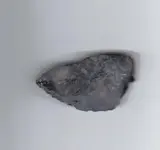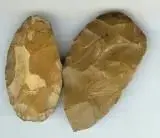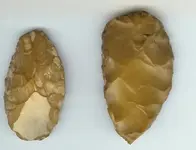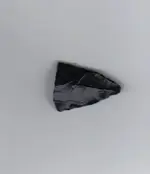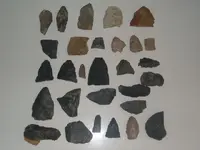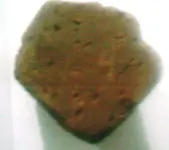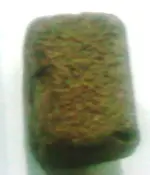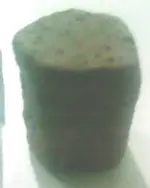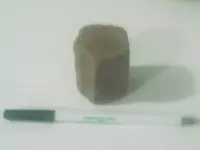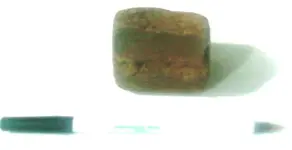You are using an out of date browser. It may not display this or other websites correctly.
You should upgrade or use an alternative browser.
You should upgrade or use an alternative browser.
Flake Tools
- Thread starter bean man
- Start date
Ohio_Doug
Hero Member
Airborne, Look at the flaking scars on the upper half of this knife. These scars are without a doubt man made. Once you learn what to look for you will know as soon as you pick it up whether its an artifact ot not. Hope this helps.
Amazon Forum Fav 👍
Attachments
A
Atlantis0077
Guest
Good Morning,
Wow, this was a great one to read over coffee. Good points made by all. Airborne, welcome to the forum and I hope you don't feel you are personally responsible for any of the sniping going on. It was well underway before you arrived and no doubt will continue for your amusement as well as education.
Bean man you are correct that you will normally recognize an artifact with 'money value' if you know the general form. I know a fellow, however, who threw back a nice celt once simply because he didn't know what one looked like. All artifacts have historical and cultural value, not all have real monetary value, but that is beside the point. You seem to have the mistaken idea that most of us that make a life's pursuit of artifacts are somehow in it for the money. Personally I don't sell artifacts....I will buy from people I know and dig with....but am not in it for the money. I wasn't when I was 8 years old and am not now.
What Cannonman and others are trying to say is that even an artifact which is crude exhibits certain characteristics. Absence of these characteristics makes it unlikely...exceeding unlikely....despite finding several examples of a similar shape...that was ever altered by the hand of man. You can use the same type of 'general rules' for locating sites. You look for placement, certain types of soil, a water source nearby, and number one, chips.....not rock, not gravel, but chips...they may be large or tiny but without chips normally you wont find other artifacts. This is a general rule. Cannonman is an accomplished flintknapper...he knows what to look for.
The majority of artifacts look like artifacts when you have the basics of identification under your belt. There is not, as some would have you believe, a whole new classification of stealth artifacts in the bottom of every creek...things that were only used once and cast aside. An artifact might get a wear pattern from use, but it is normally chipped or ground out first and then used. Not so much chipped FROM use, but chipped FOR use.
It was pointed out in a post that not all artifacts are chipped stone. This is very true. You must also remember that the same set of characteristics apply to ground stone artifacts that do chipped ones...certain things you look for, without them its probably just a rock.
Arguing over pieces accomplishes nothing.....like trying to say by a photo whether a piece is "ancient" or not. You can look for certain things which say its NOT old easier than pointing out things that say it IS. Good fakers can duplicate chipping, shape and even patina so its hard to judge based on that....if however you see a piece that is an unrecognized shape or a piece that is a known more recent type flaked as a paleo, red flags go up all over. By the same token, I can grind you an axe out of catahoula sandstone that looks wonderful in a photo, but you could crush in your hand. The indians didnt make axes out of this material and though one might look good, an authentic ancient artifact it is not.
We are all here to learn....we all have things to learn...and there is no dumb question....just unanswered ones. Experience is always the best teacher....the more you do this, the better you get at identification. I could only dream of having a resource such as this forum when I was first starting in this hobby. I can tell you if I had of, my collection today would be much larger than it is.
Here are a couple of photos of two scrapers I found, each the flipside of the other. This is the usual thing you find around here. Yellow chert with a little cortex left on the stone on one, and the other thinned a little better for cutting. Note the flaking scars on the sides and edge.
Happy Hunting,
Atlantis
Wow, this was a great one to read over coffee. Good points made by all. Airborne, welcome to the forum and I hope you don't feel you are personally responsible for any of the sniping going on. It was well underway before you arrived and no doubt will continue for your amusement as well as education.
Bean man you are correct that you will normally recognize an artifact with 'money value' if you know the general form. I know a fellow, however, who threw back a nice celt once simply because he didn't know what one looked like. All artifacts have historical and cultural value, not all have real monetary value, but that is beside the point. You seem to have the mistaken idea that most of us that make a life's pursuit of artifacts are somehow in it for the money. Personally I don't sell artifacts....I will buy from people I know and dig with....but am not in it for the money. I wasn't when I was 8 years old and am not now.
What Cannonman and others are trying to say is that even an artifact which is crude exhibits certain characteristics. Absence of these characteristics makes it unlikely...exceeding unlikely....despite finding several examples of a similar shape...that was ever altered by the hand of man. You can use the same type of 'general rules' for locating sites. You look for placement, certain types of soil, a water source nearby, and number one, chips.....not rock, not gravel, but chips...they may be large or tiny but without chips normally you wont find other artifacts. This is a general rule. Cannonman is an accomplished flintknapper...he knows what to look for.
The majority of artifacts look like artifacts when you have the basics of identification under your belt. There is not, as some would have you believe, a whole new classification of stealth artifacts in the bottom of every creek...things that were only used once and cast aside. An artifact might get a wear pattern from use, but it is normally chipped or ground out first and then used. Not so much chipped FROM use, but chipped FOR use.
It was pointed out in a post that not all artifacts are chipped stone. This is very true. You must also remember that the same set of characteristics apply to ground stone artifacts that do chipped ones...certain things you look for, without them its probably just a rock.
Arguing over pieces accomplishes nothing.....like trying to say by a photo whether a piece is "ancient" or not. You can look for certain things which say its NOT old easier than pointing out things that say it IS. Good fakers can duplicate chipping, shape and even patina so its hard to judge based on that....if however you see a piece that is an unrecognized shape or a piece that is a known more recent type flaked as a paleo, red flags go up all over. By the same token, I can grind you an axe out of catahoula sandstone that looks wonderful in a photo, but you could crush in your hand. The indians didnt make axes out of this material and though one might look good, an authentic ancient artifact it is not.
We are all here to learn....we all have things to learn...and there is no dumb question....just unanswered ones. Experience is always the best teacher....the more you do this, the better you get at identification. I could only dream of having a resource such as this forum when I was first starting in this hobby. I can tell you if I had of, my collection today would be much larger than it is.

Here are a couple of photos of two scrapers I found, each the flipside of the other. This is the usual thing you find around here. Yellow chert with a little cortex left on the stone on one, and the other thinned a little better for cutting. Note the flaking scars on the sides and edge.
Happy Hunting,
Atlantis
Attachments
Ohio_Doug
Hero Member
creekhunter
Bronze Member
- Joined
- Dec 14, 2007
- Messages
- 1,237
- Reaction score
- 572
- Golden Thread
- 0
- Location
- Cincinnati, Ohio
- Detector(s) used
- Radio Shack
- Primary Interest:
- All Treasure Hunting
Did someone say FLAKE TOOLS...


A
Atlantis0077
Guest
EUREKA!!!!
Take a good look everyone.
Atlantis
Take a good look everyone.
Atlantis
Cannonman17
Bronze Member
Beano, quick!! Come take a look!!! REAL artifacts!!!
Nice display there!
Nice display there!
creekhunter
Bronze Member
- Joined
- Dec 14, 2007
- Messages
- 1,237
- Reaction score
- 572
- Golden Thread
- 0
- Location
- Cincinnati, Ohio
- Detector(s) used
- Radio Shack
- Primary Interest:
- All Treasure Hunting
TY, I couldn't help it, these were all personally dug from a KNOWN site, lol
creekhunter
Bronze Member
- Joined
- Dec 14, 2007
- Messages
- 1,237
- Reaction score
- 572
- Golden Thread
- 0
- Location
- Cincinnati, Ohio
- Detector(s) used
- Radio Shack
- Primary Interest:
- All Treasure Hunting
you da' man!
Ohio_Doug
Hero Member
Airborne80
Bronze Member
- Joined
- Mar 23, 2005
- Messages
- 1,020
- Reaction score
- 6
- Golden Thread
- 0
- Location
- Northern Virginia
- Detector(s) used
- Whites XLT Classic
Teknetics Delta 4000
- Primary Interest:
- All Treasure Hunting
Outstanding posts from all of you. I swear... I have learned more from this one thread than everything else that I have read combined. Thanks for providing this information. I will now crop and upload a couple of pictures of that strange thing I found in the creek that everyone said needed a better photo. Stand by.
Airborne80
Bronze Member
- Joined
- Mar 23, 2005
- Messages
- 1,020
- Reaction score
- 6
- Golden Thread
- 0
- Location
- Northern Virginia
- Detector(s) used
- Whites XLT Classic
Teknetics Delta 4000
- Primary Interest:
- All Treasure Hunting
Ok...... here is that strange thing that I found in the creek. I am sorry but I had to use my cell phone camera again, so the lighting is poor. The thing here is..... look at it from all angles. It really looks and feels like fired clay... and has pebbles embedded into it. Its heavy and the ONE grove on the one side is very very smooth. Like it was made with a finger in wet clay. I really do get the feeling that its a tool perhaps used in arrow shaft making. See what you think. I will post the same pics under another post that I put in a week or so ago, so you may see these again. Thanks for any ideas in terms of what this is. Oh yea... it was in a Creek that flows through an area with a heavy Indian history.
Attachments
P
pickaway
Guest
creekhunter said:Did someone say FLAKE TOOLS...

creek that stuff is nice.looks like ridge i found dozen or so nice red ones i kept yesterday theres a ton waiting for ya next round rain washed out alot.bean if you are ever in Ohio you have an invite to go look with me.
ohioriver hunter
Sr. Member
just another bunch opf f*&^%*g rocksbean man said:I figure some of the only evidence to support a lot of crude tools, is finding multiple examples. I have quite a few, but just posted these right now, because their made of basalt and chert. It might not prove anything, but it's a start.



Not ever rock with an edge is an artifact, most are not. I spent over 20 years walking creeks, streams and fields in Missouri, found hundreds of nice artifacts, thousands of flake tools, tens of thousands of maybe's, and millions of rocks (chert).
I quit collecting the flake knives and maybe's because I could spend all day picking them up and not have any time left to look for the really nice true artifacts. Flake knives are cool, Daltons and Dovetails are cooler. .
.
There are fields over looking the Missouri River in central Missouri where the farmer plowed through what use to be a village in the early 1800's documented by French trappers, there were literally thousands of pieces of pottery laying on the ground. farmer didn't collect and didn't want anyone on his property....There is a state park that borders on his land full of mounds.
I quit collecting the flake knives and maybe's because I could spend all day picking them up and not have any time left to look for the really nice true artifacts. Flake knives are cool, Daltons and Dovetails are cooler.
 .
.There are fields over looking the Missouri River in central Missouri where the farmer plowed through what use to be a village in the early 1800's documented by French trappers, there were literally thousands of pieces of pottery laying on the ground. farmer didn't collect and didn't want anyone on his property....There is a state park that borders on his land full of mounds.
bean man
Hero Member
- #57
Thread Owner
Treasurehunter, I never said every sharp rock was used. I'm saying, it appears there are a lot of flake tools lying in some creeks. You just said the same thing youself. With this kind of tools, alot of times it's hard to tell. You either believe it's possible or you don't. No one can be right about this kind of stuff, it's impossible to prove either way. If I find multiple examples of a tool, made from materials that they used, I'm going to lean towards believing it, even if it doesn't have a lot of flaking scars. My mission is more a study of my area, so I grab everything. Sorry it offends so many people. 

Neanderthal
Bronze Member
Every rock in my driveway could've been an artifact. There's no visible sign of modification or useage..but..hey, there's an outside chance that they could've chunked them at crosseyed rabbits. Hey! All of the rocks in the creekbeds around here could've been used by them too!!! Come to think of it, all of that rock at the bottom of the rock quarry the other side of town, they may have sat on some of them...or even made early chia pets out of the mossy ones. I once found an arrowhead in squaw creek, that makes every rock in the whole creek suspect as artifact..yup.
Come to think of it..there's something mysterious and coincidental about every single rock and stick in this county (it's a magical place). Yup, I can pick up ANY stone and find something to compare it too. 5 divets on one may look EXACTLY like the placement of 5 pyramids on the giza plateau, while the next one has a knot on it that looks ungodly like the north slope of Cahokia mounds! Yup, I can even find one that matches the Orion constellation if I need to. I once saw a piece of asphalt that looked like lady godiva riding a mule backwards across the Missouri river and a cloud that looking like a chipmunk holding a garage door remote in one hand and a crumpled door hinge in the other. There were arrowheads there too - that's absolute proof that it could've been man made!
*Sigh*, that's it...I have to keep every rock now dammit. They're all something if I just think hard and look close enough.....
Come to think of it..there's something mysterious and coincidental about every single rock and stick in this county (it's a magical place). Yup, I can pick up ANY stone and find something to compare it too. 5 divets on one may look EXACTLY like the placement of 5 pyramids on the giza plateau, while the next one has a knot on it that looks ungodly like the north slope of Cahokia mounds! Yup, I can even find one that matches the Orion constellation if I need to. I once saw a piece of asphalt that looked like lady godiva riding a mule backwards across the Missouri river and a cloud that looking like a chipmunk holding a garage door remote in one hand and a crumpled door hinge in the other. There were arrowheads there too - that's absolute proof that it could've been man made!
*Sigh*, that's it...I have to keep every rock now dammit. They're all something if I just think hard and look close enough.....
bean man
Hero Member
- #59
Thread Owner
Come on Matt. I truly believe the stuff I post don't say that. Matt, you yourself have said, you see so much junk, you don't pick it up anymore. You have also said, it's all about opinion, which I agree with, can I have mine. Besides, I have never said anything was for sure. Really, what's the problem. Not enough people visiting your web site. If you want, I'll come on over and post some of my stuff. 

Bean, my post was in general and not directed to you or anything you said at all. My apologies if it appeard to you it was.
I found so many flake knives, I use to collect them but quit due to time and trouble halling them out. I chose instead to look for points, walking the fields and searching the stream beds when times were dry and water was low. I had a farmer,s field outside of Columbia Mo that had a small stream that wrapped around it on 3 sides, with high rock formations on 3 sides, open only to the southwest side. It was well protected with natural cover and had a constant source of water. there were several small natural springs feeding the stream.
I had the owners permission to hunt and there was no doubt it was a village site at many points in time due to the amount of artifacts, flakes, and core chert that flakes were broke off of to make points. The stream had a bad flash flood one year after a bad gullywasher and strip most of topsoil off, afterwards you could see where rings of small holes had been scattered over the fields, the rings were anywhere from 12 to 18 feet or so in diameter. many of them had noticable spots in the center where when you dug you found small perfectly round stones. The ring holes or ones in center were not open, but colored differently then ground around them. Holesin rings maybe originally 3-4 inches in diameter.
I walked the streams after gullywashers and found so many points. Point hunters know what I mean. My old handle was Creekwalker, and it fit. I had One-Call Maps showing all the towns, roads, rivers, streams, creeks, and natural features , and they had range, township, section and quarter sections marked on them. I could mark the finds on the map and be very close to where I was when I wanted to return. Many times I was a couple miles from my truck. I didn't have a GPS then.
Good luck and good hunting...........
I found so many flake knives, I use to collect them but quit due to time and trouble halling them out. I chose instead to look for points, walking the fields and searching the stream beds when times were dry and water was low. I had a farmer,s field outside of Columbia Mo that had a small stream that wrapped around it on 3 sides, with high rock formations on 3 sides, open only to the southwest side. It was well protected with natural cover and had a constant source of water. there were several small natural springs feeding the stream.
I had the owners permission to hunt and there was no doubt it was a village site at many points in time due to the amount of artifacts, flakes, and core chert that flakes were broke off of to make points. The stream had a bad flash flood one year after a bad gullywasher and strip most of topsoil off, afterwards you could see where rings of small holes had been scattered over the fields, the rings were anywhere from 12 to 18 feet or so in diameter. many of them had noticable spots in the center where when you dug you found small perfectly round stones. The ring holes or ones in center were not open, but colored differently then ground around them. Holesin rings maybe originally 3-4 inches in diameter.
I walked the streams after gullywashers and found so many points. Point hunters know what I mean. My old handle was Creekwalker, and it fit. I had One-Call Maps showing all the towns, roads, rivers, streams, creeks, and natural features , and they had range, township, section and quarter sections marked on them. I could mark the finds on the map and be very close to where I was when I wanted to return. Many times I was a couple miles from my truck. I didn't have a GPS then.
Good luck and good hunting...........
Similar threads
Users who are viewing this thread
Total: 1 (members: 0, guests: 1)





